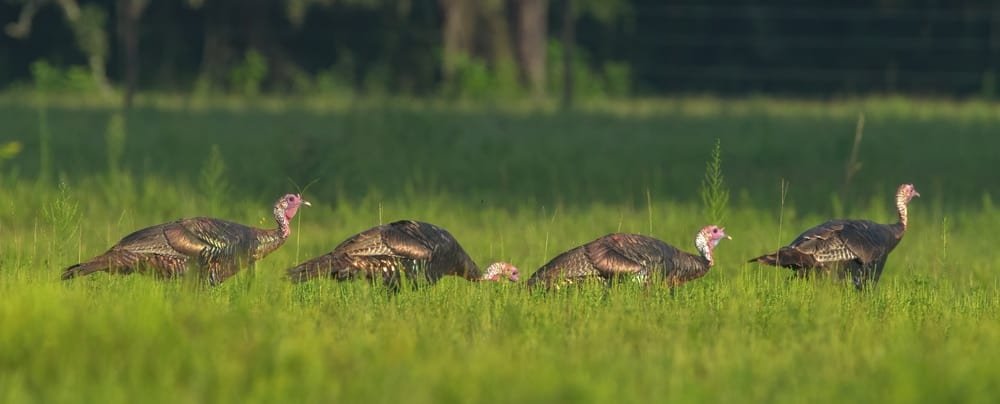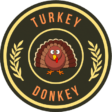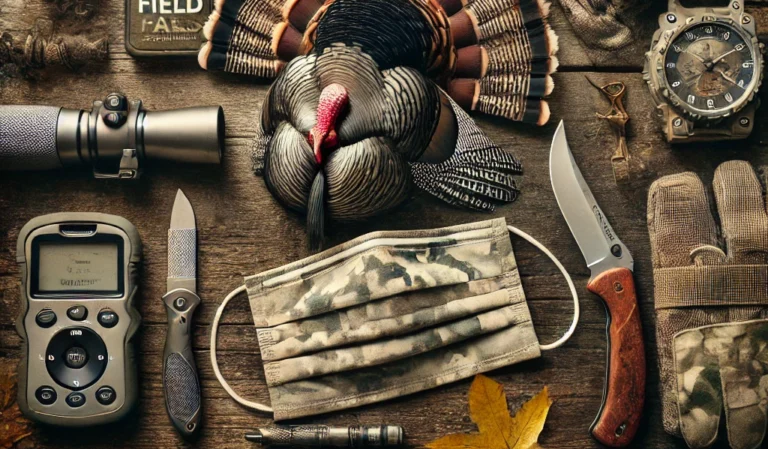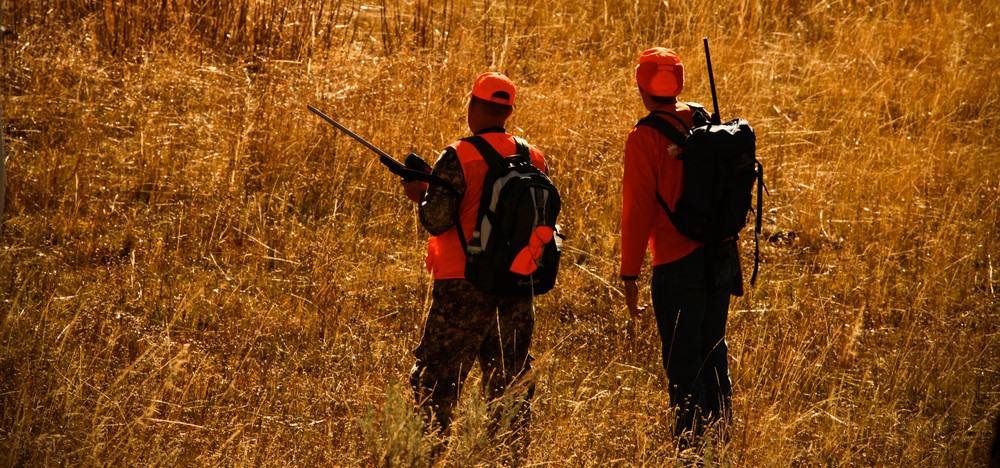Turkey Hunting 101: How to Turkey Hunt Today
Turkey hunting is a cherished tradition and an exhilarating outdoor pursuit enjoyed by countless enthusiasts worldwide. In this article, we’re going to teach you how to turkey hunt like a pro. Let’s get goin’!
Turkey hunting combines the thrill of the chase with the beauty of nature, creating an experience like no other. This highly engaging activity involves tracking and hunting wild turkeys native to various regions in North America, such as Eastern, Osceola, Rio Grande, Merriam’s, and Gould’s species.
The popularity of turkey hunting stems from its captivating challenges and rewards. Hunters must employ stealthy tactics, patience, and strategic thinking to outwit these majestic birds.
The satisfaction derived from successfully outmaneuvering a wily gobbler is unparalleled. However, it is essential to recognize that turkey hunting is not merely about harvesting game; it’s about immersing oneself in nature and embracing the cycle of life in the wilderness.
Brief Overview of Turkey Hunting as a Popular Outdoor Activity
Turkey hunting has evolved over centuries from a means for sustenance and survival to an esteemed sport celebrated by passionate outdoorsmen and women. This exciting pursuit originated in Native American cultures, where it was both a way to procure food and a revered tradition passed down through generations.
Today, turkey hunting has gained widespread popularity among hunters who seek adventure amidst breathtaking landscapes. The allure of turkey hunting lies partially in its dynamic nature—each hunt presents unique challenges due to variations in terrain, weather conditions, and turkey behavior patterns.
Whether stalking through dense forests or setting up blinds near open fields or water sources, each environment demands different strategies for success. Moreover, the unpredictable temperament of turkeys adds an element of excitement; their ability to abruptly change direction or exhibit evasive behavior tests hunters’ skills and adaptability.
Importance of Proper Planning and Preparation for a Successful Hunt
To maximize your chances of success while ensuring safety and ethical hunting practices, thorough planning and preparation are paramount. Adequate research and knowledge about turkey behavior, habitat preferences, and hunting regulations are fundamental prerequisites for a fruitful hunt.
Understanding the target species is crucial. Differentiating between Eastern, Osceola, Rio Grande, Merriam’s, and Gould’s turkeys will help you adapt your tactics accordingly.
Gaining insights into their roosting patterns, feeding areas, and breeding behavior enables you to identify the most productive locations for your hunt. Furthermore, acquiring proficiency in turkey calls—such as slate, box, or mouth calls—and learning to utilize decoys effectively will significantly enhance your chances of attracting turkeys within range.
Equally important is the selection of appropriate gear for turkey hunting. This includes choosing the right firearm (such as shotguns or bows), ammunition, or broadheads that ensure ethical kills while preserving meat quality.
Additionally, investing in high-quality camouflage clothing that matches the surrounding environment enables hunters to blend seamlessly with their surroundings, increasing their chances of remaining undetected by sharp-eyed turkeys.
By dedicating ample time and effort to meticulous planning and robust preparation before embarking on a turkey hunt adventure, hunters can elevate their experiences from mere excursions to unforgettable encounters with nature’s finest game birds.
Differentiating between Wild Turkey Species
Before embarking on a turkey hunting adventure, it is crucial to familiarize oneself with the different wild turkey species that inhabit various regions of North America.
Each species possesses unique characteristics and habitats, making it important for hunters to identify their target correctly. Eastern Turkey (Meleagris gallopavo silvestris) is the most widely hunted species.
With its dark feathers and iridescent plumage, Eastern Turkey thrives in wooded areas of the eastern United States and parts of Canada. On the other hand, the Osceola Turkey (Meleagris gallopavo osceola) can be found exclusively in Florida’s peninsula, boasting vibrant feathers that feature shades of green and bronze.
In more arid regions such as Texas, Oklahoma, Kansas, and some parts of Mexico, you’ll encounter the Rio Grande Turkey (Meleagris gallopavo intermedia). This species has lighter-colored feathers with hints of copper.
Moving towards western states like Arizona and New Mexico leads us to Merriam’s Turkey (Meleagris gallopavo merriami), known for its snow-white tail feathers contrasting against dark wings. Last but not least is the rarest and most sought-after species: Gould’s Turkey (Meleagris gallopavo mexicana).
This magnificent bird inhabits remote areas of northern Mexico and small pockets in Arizona and New Mexico. It displays elongated tail feathers with beautiful white, brown, black, and gold bands.
Learning About Turkey Behavior & Habitat Preferences
Roosting Patterns & Locations
Turkeys have distinct roosting patterns that are crucial in planning your hunt. In the late afternoon or early evening hours before sunset, turkeys fly up to roost in tall trees, seeking safety from predators.
Roost sites vary based on the terrain, with popular choices including mature hardwood trees, pines, or even old buildings. Identifying these roost locations is key, as turkeys repeatedly return to the same area.
Hunters can spot potential roost sites by looking for signs such as droppings and feathers beneath trees or observing turkey behavior at dusk when gathering in groups before flying up to their roosts. Remember that approaching roost sites silently is essential to avoid alerting the turkeys and preventing them from changing their routines.
Feeding Areas & Habits
Understanding a turkey’s feeding habits allows hunters to anticipate their movements. Turkeys are opportunistic omnivores that feed on various foods, including nuts, seeds, fruits, insects, and even small reptiles.
Preferred feeding areas often consist of open fields adjacent to wooded patches or along forest edges where they find abundant food sources. Scouting for turkey tracks and scratch marks on the ground can offer valuable insights into their feeding patterns.
Additionally, watching for flocks of turkeys moving across fields during the early morning or late afternoon provides clues about their preferred feeding areas. By identifying these locations in advance and positioning yourself strategically nearby, you increase your chances of encountering turkeys during hunting hours.
Strutting Zones & Breeding Behavior
The breeding season presents unique opportunities for turkey hunters as male turkeys showcase elaborate courtship displays known as strutting. During this period – usually in spring – male turkeys puff out their feathers into magnificent fans while displaying vibrant colors on their heads and necks.
Strutting zones are typically open areas with high visibility so that gobblers can attract the attention of hens.
These zones may include meadows, old logging roads, or powerline clearings. Listening to the distinctive gobble of a male turkey is a surefire sign that you are in or near a strutting zone.
Understanding turkey behavior and habitat preferences is fundamental when embarking on a successful hunt. By differentiating between species, locating roosting sites, identifying feeding areas, and recognizing strutting zones, hunters can plan their strategies accordingly and increase their chances of a memorable turkey hunting experience.
Essential Gear for Turkey Hunting
Firearms options: shotguns vs. bows
When choosing the right weapon for turkey hunting, two popular options are shotguns and bows. Shotguns have been the traditional choice for many hunters due to their widespread and high pellet count, increasing the chances of hitting a moving target. The recommended gauge for turkey hunting is typically 12 or 20, with 3-inch or 3.5-inch shells delivering ample firepower.
On the other hand, bows offer a different thrill and challenge, requiring greater precision and stealth to get close enough for an ethical shot. Bowhunting for turkeys can be incredibly rewarding, providing a heightened sense of achievement when successfully harvesting a bird.
Choosing the right ammunition or broadheads for ethical kills
The appropriate ammunition or broadheads is critical to ensure an ethical kill during your turkey hunt. For shotgun hunters, specialized turkey loads feature tight patterns and heavier pellets designed to deliver ample force at extended ranges.
It is essential to pattern your shotgun with different loads beforehand to determine which one provides consistent patterns at various distances you plan on shooting from.
When using a bow, broadhead selection becomes crucial as well. Mechanical broadheads that open upon impact provide better accuracy, while fixed-blade broadheads often possess more penetrating power but require stricter shot placement.
Camouflage clothing: patterns and considerations for blending into the environment
Turkey hunting demands effective concealment through quality camouflage clothing that blends seamlessly into the surrounding environment. Opting for camo patterns that mimic natural elements like leaves, branches, or dirt will help you disappear into your surroundings, making it harder for turkeys to spot any movement you make.
Additionally, consider wearing full camouflage, face masks, or paint to conceal exposed skin. Considering the season and terrain you will be hunting in is also crucial.
Choose patterns that match the foliage during spring hunts or opt for more muted colors during fall hunts when leaves have changed. Remember to stay motionless and use covers such as trees or blinds to enhance camouflage effectiveness.
Calls: slate calls, box calls, mouth calls – their purpose and how to use them effectively
Calls play a vital role in turkey hunting, allowing hunters to imitate various turkey vocalizations to attract birds within shooting range. Slate calls consist of a wooden or synthetic base with a slate surface, producing realistic purrs, clucks, and soft yelps when used with a striker. Box calls feature a hinged lid dragged across the top of the box’s sound chamber, creating raspy yelps and loud cutting sounds.
Mouth or diaphragm calls are placed inside the hunter’s mouth and produce a wide range of turkey sounds by manipulating tongue pressure and airflow. Each type of call has its advantages. However, it is recommended to carry multiple options if one doesn’t work well on a particular day due to various factors such as weather conditions or specific turkeys’ preferences.
Decoys: different types available (Jake, hen, strutter) and decoy placement strategies
Decoys are powerful tools for luring turkeys closer by creating visual attraction during hunts. There are several types of decoys available on the market, including Jake (young male), hen (female), and Strutter (dominant male). Jake decoys can provoke aggressive responses from older gobblers, while hen decoys can entice males and females to seek companionship during the breeding season.
Strutter decoys replicate an adult gobbler displaying his dominance which can challenge other mature gobblers in proximity. When deploying decoys for turkey hunting, proper placement is vital.
Position them within sight of approaching turkeys, preferably in open areas where their attention can be drawn, but ensure you have clear shooting lanes. Experimenting with different setups and decoy configurations can help increase your chances of success during your turkey hunt.
Preparing for the Hunt
Researching hunting regulations specific to your area
Before embarking on your turkey hunting adventure, it is crucial to familiarize yourself with the hunting regulations specific to the area you will be hunting in. Each jurisdiction may have rules and restrictions regarding when, where, and how you can hunt turkeys. These regulations are in place to ensure sustainable turkey populations and protect other wildlife species.
Visit the website of your local wildlife agency or contact them directly to obtain the most up-to-date information on seasons, bag limits, licensing requirements, and any special permits needed. Adhering strictly to these regulations for ethical reasons and to avoid legal consequences is essential.
Scouting techniques
Successful turkey hunting begins with effective scouting techniques. By studying maps of your hunting area, you can identify potential hotspots where turkeys are likely to be present.
Look for areas that offer a combination of suitable roosting sites, such as large trees near water sources or open fields, feeding areas like agricultural fields or forest clearings with abundant food sources like acorns or insects, and strutting zones where dominant males display their feathers during the breeding season. Watch for signs of turkey presence in the environment when scouting on foot.
Look for tracks in muddy areas or soft soil that indicate recent activity. Turkey droppings can also be clues since they are commonly found near feeding areas or along established travel routes.
Feathers scattered around certain spots may suggest a strutting zone nearby. Additionally, listening for gobbling during early mornings or late evenings can provide valuable information about turkey activity patterns in specific locations.
Turkeys often vocalize from their roosting sites at daybreak and right before dusk when they fly up into trees again. By paying attention to these natural sounds and noting their directionality, you can gain insights into potential hunting spots for a higher chance of success.

Tactics & Strategies During the Hunt
Deciphering Turkey’s Favorite Spots
Regarding turkey hunting, selecting the right location for your setup can make all the difference. Understanding where turkeys spend their time throughout the day is crucial. At dawn, positioning yourself near roost sites is highly effective.
Turkeys typically roost in tall trees to protect themselves from predators during the night. By getting close to their roosting areas, you have a higher chance of encountering them as they descend from their lofty perches at first light.
Later in the day, turkeys focus on feeding. Identifying preferred feeding areas, such as open fields with ample food sources like insects, seeds, and young vegetation, is key.
Setting up close to these locations increases your chances of encountering turkeys actively searching for sustenance. During breeding season or when you hear gobbling in an area known for strutting zones, targeting these locations becomes paramount.
Male turkeys showcase their magnificent displays of fanning tail feathers and puffing out chests to attract hens during this time. By positioning yourself near strutting zones, you significantly increase your likelihood of witnessing this captivating ritual and potentially luring a tom within range.
Calling Techniques
Mastering the Art of Conversation
Once you have established a strategic location, effective calling techniques become essential for luring turkeys within shooting range.
Turkey calls come in various types, such as slate calls, box calls, and mouth calls, each with unique sound qualities and purposes. Starting with soft yelps and purrs can be an excellent way to mimic contented hens that may draw curious gobblers toward your setup.
If you do not receive any response or competition from other nearby hunters using similar tactics, employing more aggressive calling methods like cutting or excited yelping can spark the interest of dominant toms, enticing them to investigate your location. Keeping in mind that turkeys have keen hearing, it is crucial to adjust the volume and intensity of your calling accordingly.
Strive for realism by incorporating pauses, rhythm variations, and realistic cadence. Incorporating soft clucks or purrs between calls can add authenticity to your Turkey language repertoire.
Conclusion
Turkey hunting is an exhilarating outdoor pursuit that requires careful planning and execution. By understanding turkey behavior and learning their preferred habitats, you can strategically position yourself in prime locations during different times of the day.
Setting up near roost sites at dawn, feeding areas later in the day, or strutting zones during the breeding season can significantly increase your chances of success. Mastering various calling techniques will further enhance your ability to lure turkeys closer and provoke their natural curiosity.
Remember that patience and persistence are key virtues when hunting these majestic birds. You’ll become a skilled conversationalist in Turkey language with practice and attention to detail.
So venture forth with confidence! Immerse yourself in nature’s symphony as you listen for gobbling echoes through the trees at sunrise.
Appreciate the beauty of turkeys connecting with their environment as you study their behavior. And ultimately, embrace the thrill when all your preparation culminates in a successful hunt that rewards skill and respect for these magnificent creatures.







